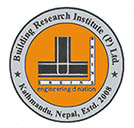
Today (NST)
Monday, Jun 16, 2025
Smart Search
Please post in your Technical Queries, Comments & Suggestions to Contact us......
Advertisement

For Advertisement
|
|
| Subscribe to BREINS Sci-Tech |
| Visit this group |

Material Testing
Steel, Concrete and Brick masonry are the major types of structural material used in Civil Engineering Construction. Also, Soil on which structures are founded can be considered as a structural material as it gets loaded too.
Properties of various kinds of above mentioned materials along with its constituents can be assessed by means of various lab and field tests.
Compressive & Tensile strength tests are two major strength tests conducted on concrete. Strength usually gives an Overall Picture of the quality of concrete because it is directly related to the structure of cement-paste.
Compression Test of the Concrete Specimen is most widely used test to measure its compressive strength. Two types of concrete specimen: Cubes & Cylinders are used for this purpose:
Cubes of size 150mm are more common in Asia, Russia & European countries while Cylinders of 150mm in diameter & 300mm high are common in U.S and Australia.
Fig-1 (Various Failure Modes of a Concrete Cube & Cylindrical Specimen under the Comression Loading Test)
Note : Figure taken from International Student Edition, "Concrete Technology" by A.M. NEVILLE & J.J. BROOKS.
Cubes for compression test are casted in a steel or cast-iron moulds of prescribed dimensions. BS 1881: Part 108: 1983 prequires filling the mould in layers of approximately 50 mm. Compaction of each layer is achieved by not less than 35 strokes for 150mm cubes or 25 strokes for 100 mm cubes. A standard tamping bar of a 25mm square of steel section is used for this purpose. Compaction by vibration may also be used.
After finishing the cube, it should be stored at a temperature of 150C to 250C, when the cubes are to be tested at or more than 7 days. When the test days is less than 7 days the temperature to be maintained is 180C to 220C. Also, relative humidity of 90 percent is to be maintained always.
The cube is demoulded just before testing at 24 hours. For greater ages at test, demoulding takes place between 16 to 28 hours after adding water in a concrete mix and the specimens are stored in a curing tank at 180C to 220C until the required age.
The most common age at testing is 28 days, but tests can be made at 1, 3, 7 & 14 days also. At the time of testing the specimen is placed in a "Compression Testing Machine" with the position of cubes at right angles to the position of cast. The load is applied at a constant rate of stress within the range of 0.2 to 0.4 MPa/sec.
Under pure uniaxial compression loading, the failure cracks generated are approximately parallel to the direction of applied load (Fig-1) with some cracks formed at an angle to the applied load. Practically, the compression testing system rather develops a complex system of stresses due to end restraints by steel platens.
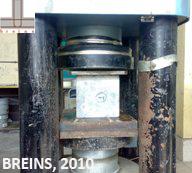
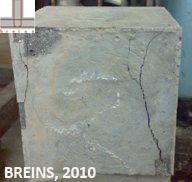
Fig-2 ( A Concrete Cube Undergoing Comression Loading Test at the Compression Testing Machine (CTM) and its Failure Pattern)
It is quite clear that due to Poisson's effect, cube or cylinder specimens undergo lateral expansion. The steel platens don't undergo lateral expansion to the same extent that of concrete. There exists a differential tendencies of lateral expansion between steel platens and concrete cube faces; as a result of which tangential forces are induced between the end surfaces of the concrete specimen and the adjacent steel platens of the testing machine (Fig-2). The degree of platen restraint on the concrete section depends on the friction developed at the concrete-platen interfaces, and on the distance from the end surfaces of the concrete.
As a result, in addition to applied compressive stress, lateral shearing stresses are also effective in the concrete specimen. Effect of this shear decreases towards the centre of cube; so that sides of cube have near vertical cracks at cube's centre (Fig-2), or completely disintegrates so as to leave a relatively undamaged central core.
As the degree of end restraint depends on the friction at the interfaces, this frictional value can be eliminated by applying grease, graphite or paraffin wax to the bearing surfaces of the specimen. It helps the specimen to undergo a larger and uniform lateral expansion and eventually splits along its full length.
It should be noted that with end restraints in full effect, the compression test yields the higher value of cube strength. When the height of specimen increases with respect to its width, the influence of shear becomes smaller so that the central part of the specimen may fail by lateral splitting; thereby exihibiting the lower compressive strength. It is depicted in Fig-2 & 3.
Specimen Shape & Size Effect
The different sizes and shapes of test specimen used for determining the compressive strength of concrete along with the strength modification factors are given in table below:
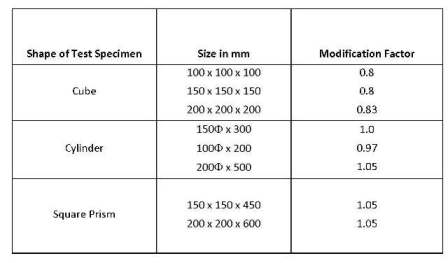
Table-1 (Modification Factors on Conversion of Strength of Concrete Specimens of various Shapes & Sizes)
It has been observed from the above table that the strength depends upon the shape, size & proportion of sides of test specimen. This dependence is known as Specimen Effect. The compressive strength is found to be highest for the cube specimen 150 mm and below.
The prismoidal compressive strength of concrete has been found to decrease
with the increase in the ratio of height ‘h’ to lateral dimension ‘d’
till it reaches a value of 4 (h/d=4), beyond which it approximately remains
constant equal to 0.7 times the strength of cube for which h/d ratio equals
to unity.
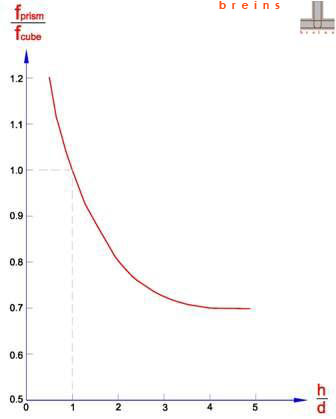
Fig-3 (Variation of the Prismoidal Strength with h/d ratio)
The strength of concrete also decreases with the size of the specimen
till its lateral dimension is 450mm, and all larger specimens or members
give approximately the same strength. This is evident from the fact that
the probability of occurrence of weak spots is greater when the volume
of the concrete is larger for a given stress level to which it is subjected.
This is true to some extent because smaller specimen can be better compacted
and also exhibit a smaller amount of bleeding, as a result, the concrete
would be of better quality, and therefore, stronger.